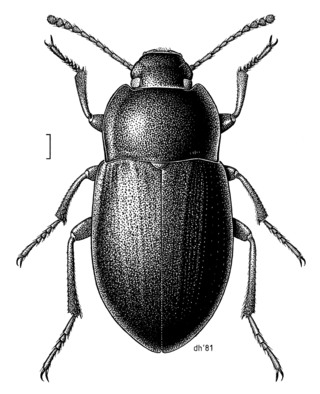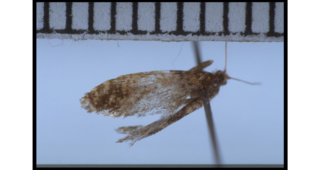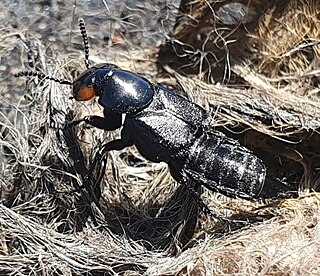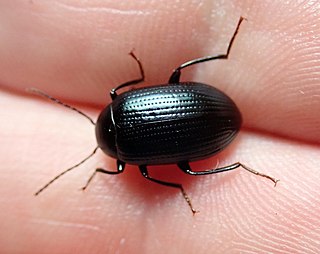
Lynfield is a suburb of Auckland, New Zealand. It is under the local governance of Auckland Council. The suburb is located on the southwestern Auckland isthmus bordering the Manukau Harbour, much of which is densely forested with native forest. Lynfield was developed for suburban housing in the late 1950s and 1960s, modelled after American-style suburbs.

Hadramphus, commonly known as knobbled weevils, is a genus of flightless molytine weevils from the family Curculionidae. It is endemic to New Zealand and consists of four species.

Peristoreus fulvus is a species of true weevil. It is endemic to New Zealand. It is associated with plants of the genus Muehlenbeckia.

Turbott's weevil is a weevil that is endemic to New Zealand. It has been found on the Hen and Chicken Islands, the Poor Knights Islands and the Three Kings Islands.
Macrocoma splendidula is a species of leaf beetle endemic to the Canary Islands, described by Thomas Vernon Wollaston in 1862.

Mimopeus elongatus is a species of darkling beetle in the subfamily Tenebrioninae, first described by Ferdinando Arborio Gattinara di Breme in 1842, who considered it a type of Cilibe.

Mallobathra campbellica is a moth of the family Psychidae. This species is endemic to New Zealand and is found only on Campbell Island.

Creophilus oculatus or devil's coach horse is a species of large carrion-feeding rove beetle endemic to New Zealand.

Amarygmus is a genus of darkling beetles. It is in the tribe Amarygmini and is the oldest genus of the tribe. The genus occurs in Australia, New Guinea, Hawaii, Africa and Eurasia.
Tiphobiosis kuscheli is a species of caddisfly belonging to the family Hydrobiosidae. The species was first described by Keith Arthur John Wise in 1972, and is endemic to the Auckland Islands of New Zealand.
Aucklandobius turbotti is a species of stonefly in the family Gripopterygidae. The species was first described by Joachim Illies in 1963, and is endemic to the Auckland Islands of New Zealand.
Exeiratus turbotti is a species of weevil belonging to the family Curculionidae. The species was first described by Albert Eugene Brookes in 1951, and is endemic to the Auckland Islands in New Zealand.

Stephen Ernest Thorpe was an English-born entomologist in New Zealand. He contributed vast amounts of data and analysis in many contexts, particularly to iNaturalist. Thorpe was a member of the research group that described the beetle genus Neodoxa in 2003. In 2011, he helped with describing the New Zealand marsh beetle species Stenocyphon neozealandicus by recognising the species among unsorted insect specimens at Auckland War Memorial Museum while he was volunteering. Thorpe was murdered on 24 August 2024 during his daily walk to search for insects and plants. Thirteen species were named after Thorpe.

Cyparium thorpei is a species of rove beetle belonging to the family Staphylinidae. The species was first described by Ivan Löbl and Richard A. B. Leschen in 2003, and is endemic to New Zealand.

Cryptoxilos thorpei is a species of parasitoid wasp belonging to the family Braconidae. The species was first described by Scott R. Shaw and Jocelyn A. Berry in 2005, and is endemic to New Zealand.

Sagola thorpei is a species of rove beetle belonging to the family Staphylinidae. The species was first described by Jong-Seok Park and Christopher E. Carlton in 2014, and is endemic to New Zealand.

Pseudopisalia is a monotypic genus of rove beetle belonging to the family Staphylinidae. The sole species found in this genus is Pseudopisalia turbotti. Both the genus and species were first described by Malcolm Cameron in 1950. Pseudopisalia turbotti is endemic to Manawatāwhi / Three Kings Islands in New Zealand.

Wairaki Stream is a stream in the suburb of Lynfield in Auckland, New Zealand. One of two named streams that flows into the Manukau Harbour from the Auckland isthmus, the stream is primarily surrounded by reserves, and is a home for native bird and plant species. During suburban development, the mouth of the stream was fed into a culvert, and a stone wall constructed in Lynfield Cove, where a park was developed on the reclaimed land. The beetle species Microscydmus lynfieldi was first discovered at Wairaki Stream.

The Auckland Region of New Zealand is home to numerous endemic flora and fauna. Many of these species have ranges restricted to the Waitākere Ranges, Great Barrier Island, Little Barrier Island and the Mokohinau Islands. A number of species have restricted ranges that include areas outside of the Auckland Region, such as Buller's shearwater and Pycroft's petrel, or organisms such as the brown teal / pateke and stitchbird / hihi which have recently increased ranges due to conservation efforts.
Lindbergia maritima is a species of moss in the family Leskeaceae. The species is endemic to New Zealand, occurring at only a single rocky coastal location near Piha, in the Auckland Region, New Zealand.















